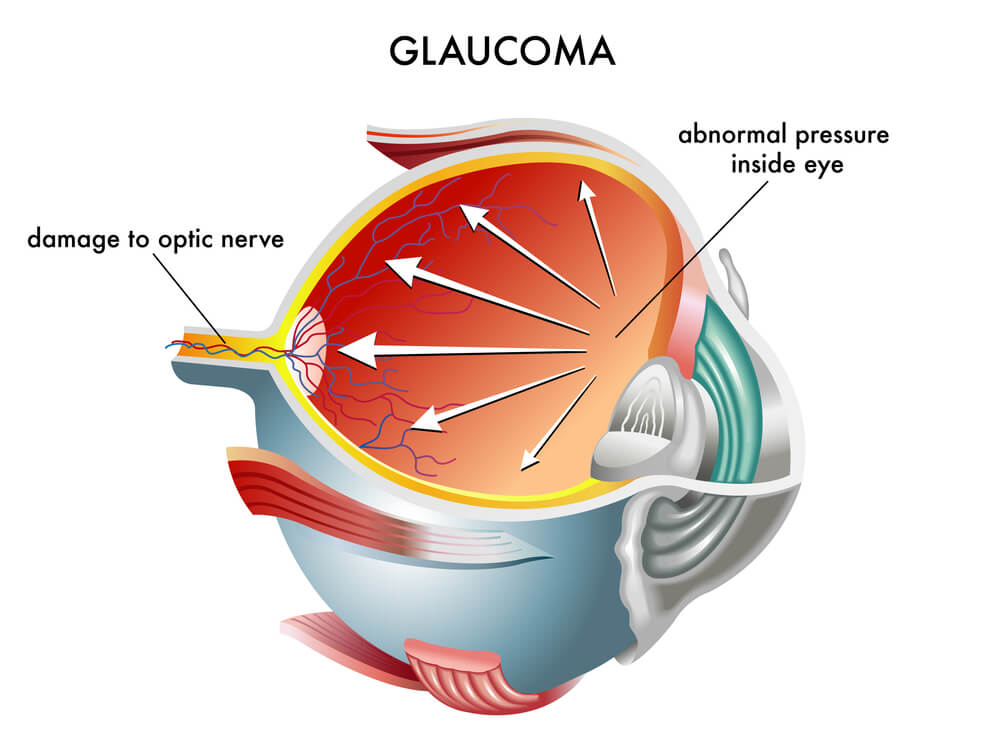Glaucoma is a disease of the eye characterized by damage to the optic nerve due to elevated intraocular pressure. It is traditionally diagnosed by the combination of three major tests: intraocular pressure measurement (tonometry), evaluation of the appearance of the optic nerve during the dilated eye exam, and visual field testing (perimetry).
In the primary form of glaucoma, open-angle glaucoma, there is a higher than normal intraocular pressure.

This elevation leads to damage of the nerve fiber layer of the retina that collects to form the optic nerve. An optic nerve affected by glaucoma will show”cupping” or extreme loss of nerve fiber tissue. A visual field test would then reveal some loss of peripheral or side vision.
Fortunately, there are several medical and surgical therapies for glaucoma that successfully lower intraocular pressure and ultimately save vision in affected patients. The key to effective glaucoma treatment is an early diagnosis.
In addition to the measurement of corneal thickness and the use of a Humphrey Visual Field machine, we are now proud to add Optical Coherence Tomography (OCT) to the list of testing machines in our practice. The OCT is the latest diagnostic technology available to monitor the nerve fiber layer of the retina and the optic nerve.
Using a scanning laser, the OCT is able to give our doctors both quantitative and qualitative data about the possible loss of nerve tissue and optic nerve damage. Studies have shown that up to 50% of nerve fiber must be lost before a visual field defect is noted on a visual field test.
By utilizing baseline and yearly scans with the OCT, we are now able to monitor for and address any small changes to the eye before further damage transpires.
Treatment Options
In the treatment options for glaucoma, most first-line therapies involve the use of eye drops to lower the intraocular pressure in the eyes. If drops have proven over time not to be adequate in the maintenance of low pressure, we offer many state-of-the-art lasers and surgical options to treat glaucoma.
During a comprehensive consultation with our doctors, if a procedure is decided upon, you may be offered one of the following techniques:
- Selective Laser Trabeculoplasty (SLT): For uncontrolled pressures in open-angle glaucoma; a laser technique that works on the drainage filter in the eye to reduce fluid outflow resistance and lower intraocular pressure.
- Laser Peripheral Iridotomy (LPI): For narrow-angle glaucoma; a small opening in the iris is created with a laser to prevent a sudden increase in pressure in the eye (acute closed-angle glaucoma).
- Endoscopic Cyclophotocoagulation (ECP): For both open and narrow-angle glaucoma; an intraocular laser procedure that focuses on the part of the eye that creates the fluid. Treatment reduces fluid production that in turn, reduces intraocular pressure.
- Mini-Express Tube Shunt Implantation: The implantation of a small drainage tube to increase the outflow of the eye fluid and maintain low intraocular pressure.
iStent
If you have glaucoma, controlling eye pressure is extremely important to reduce the risk of vision loss. By improving the outflow of fluid from your eyes, the iStent, which is placed in your eye during cataract surgery, works to help control your eye pressure.
If you have both glaucoma and cataracts, iStent may be right for you. Call our office or click here to visit our cataracts page to read more.













